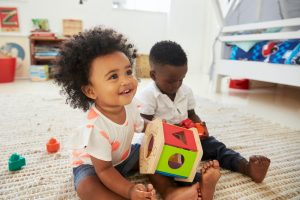 Ah, TOYS! There’s no shortage of options for surprising your little one with something fun! Before you start shopping, remember that it’s possible to keep your child’s play interesting without buying new toys. But when you’re on the hunt for something special, you should consider a few things before grabbing the latest trinket on the shelves.
Ah, TOYS! There’s no shortage of options for surprising your little one with something fun! Before you start shopping, remember that it’s possible to keep your child’s play interesting without buying new toys. But when you’re on the hunt for something special, you should consider a few things before grabbing the latest trinket on the shelves.
Highlights:
|
What to Consider When Buying New Toys
At one point or another, every parent and caregiver presents a brand new toy that captures their child’s attention… for about ten minutes, then it sits and collects dust. Unfortunately, many toys aren’t built for long-term play, and some can even be dangerous or bad for the environment. To get the biggest bang for your buck, consider the following factors when choosing toys.
Developmentally Friendly
Think about the milestones your baby or toddler is working towards when looking for playtime items. For instance, toys like teething rings or rattles that support newborns’ sensory development, or push-pull toys to nurture active toddlers’ gross motor skills.
Beware of toys that claim to boost development, but are really just multifunctional devices with colors, lights, sounds, and music. Remember that you want toys that invite engagement, not a toy that simply entertains. If the toy is the one doing all the work, it’s not as developmentally friendly as it may seem.
Encourages Problem-Solving
Toys that nurture curiosity and encourage exploration are great for building problem-solving and critical thinking skills. Puzzles, blocks, nesting cups, and play-dough are great examples of toys that help little ones experiment with varying approaches and solutions. Percussion instruments (drums, keyboards, bongos, maracas) are another excellent option because they build hand-eye coordination and teach things like cause and effect.
Sparks Creativity and Imagination
We all remember the days of make-believe! The best part about exercising the imagination is that pretend play items can provide tons of developmental benefits. Bonus: you don’t necessarily have to buy anything to encourage pretend play!
Children can play dress-up with old clothes, and a big cardboard box can suddenly turn into a pirate ship or a race car. Open-ended toys, which are toys that can be played with in a variety of ways, are also great for boosting creativity. Some examples are drawing tools, dolls, dollhouses, magnetic tiles, blocks, Legos, and wooden figurines.
Provides Real-World Experiences
Toys that are replicas of real-world items, such as car keys, phones, stovetops, food, and dishes, can help your little one learn through imitation and figure out how these objects work in the world. These smaller versions of the real thing can also boost development, like when they use fine motor skills to “cook” you lunch or language skills to “talk” to grandma on their play phone.
Encourages Action
Movement fuels skill acquisition and promotes independence. Try to incorporate toys that allow your child to be active. Classic playthings like balls, bubbles, wagons, and tricycles are great for building motor skills like kicking, running, jumping, and balancing.
Fun for Everyone
Children gain many benefits from parents and siblings engaging in play with them. Try to find toys or cross-generational games that encourage everyone in the family to participate. Next time you’re looking for something fun for your child, ask yourself, “What do I want to play?”
Safety and the Environment
Last but not least, consider safety and the environment when choosing toys. Do a little research and determine if your child’s preferred toys have been recalled or contain dangerous toxins in the plastics or pigments. In addition, remember that too many plastic toys eventually get thrown out and end up in our oceans or landfills. Consider aiming for environmentally-friendly toys made of sustainable materials.
Don’t forget to check out the BabySparks program for tons of great developmental activities that showcase toys like crayons, blocks, balls, bubbles, puppets, and more!








